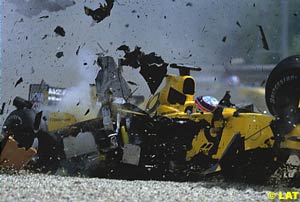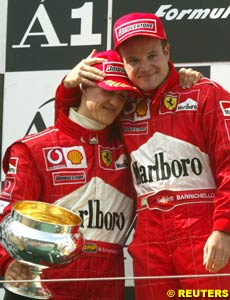
Atlas F1 Columnist
This week's Grapevine brings you |
All the noise over Ferrari's very public office politics has distracted from one of the biggest success stories the sport has to offer - the continuously improving standards for driver protection.
The current side impact test is considered fairly tough to pass. The FIA regulations require the chassis impact structure to withstand forces which, very simplified, are equivalent to another F1 car hitting it square at thirty-six km/h. without any damage to the cockpit. Clearly, Heidfeld's impact with Sato was an order of magnitude greater than this, and well beyond the official limits of the structures involved. For the Japanese driver to come away with just severe bruising from his limbs being thrown around the cockpit, then the wall collapsing into and trapping his leg, is as much of a miracle as Villeneuve repeatedly walking away from spectacular impacts with the barriers at Eau Rouge.
Max Mosley and the FIA have not been distracted by Ferrari's antics, however; and there are plans afoot to improve safety again for the next two seasons: the undertaking to leave chassis rules alone for two years does not preclude changes as and when the governing body sees fit to improve safety. In the name of safety, the side and front impact tests are to be made tougher - reputedly by 30 to 50 percent - to be completed ahead of the season.
Furthermore, after the large number of front and rear wings that were lost in Spain, there is talk of bringing on two new scrutineering tests to play, which effectively enforce minimum loading tests. It is suggested that the front wing will need to be able to withstand an eighty kilo mass at the centre, and thirty at either end, whilst the rear wing will be subjected to twice that (vertical) loading. If the tests can be defined in a practical fashion, then the FIA are expected to talk to Ferrari, Williams and McLaren about joint research to establish realistic amounts to assign to the values, and directions to test in other than "straight down."
Either way, looking to the future, no-one in the paddock is denying that continuing to improve driver safety is a good thing, despite the current, cost sensitive environment.
As the Grapevine mentioned last week, going to Austria, Toyota thought they had something to show in Austria, and as it turns out, they did.
The race itself did not unfold according to plan. Without the safety car periods, Toyota's race modelling software predicts their final positions as sixth and eighth with over seventy percent confidence. Fifth and seventh was next most likely, followed by seventh and eighth, but they really think there was a chance to get Salo ahead of Coulthard as the race unwound.
In the event, of course, the safety car did come out, and Toyota were not ready for it. Had they been in a position to make pit-stops as the first period started, they would have been able to get Salo back out with track advantage over Fisichella: a free switch to a two stop strategy would have saved enough time in the second stop to really make a difference.
Of course, it's all very well to feed the other team's lap times into a computer, then calculate who could have done what, in order to maximise the results after the race! The trick is to predict what other teams will do accurately ahead of the event, and then to execute a plan flawlessly, taking accurate advantage of unexpected opportunities as they arise. But of course, they know that at Toyota, and they are learning fast.
The crowds booing Schumacher's win in Austria were not the first to do so, even if they have proved the loudest to date: when Coulthard moved over for Hakkinen in Australia '98, the opening race of the season, McLaren faced the same boos, and similar criticism afterwards.
Last year, when Rubens Barrichello moved over from second place to hand Schumacher the points, the disappointment was written all over his face as his number two status was brought home. The team was castigated in the press, but justified the move, stating it minimised Coulthard's win, closing on his points lead. Barrichello, meanwhile, was rewarded with a contract for another year at the team.
This year, given the use Barrichello had made of the F2002 in qualifying to date, pushing Schumacher to the limit, it was a fair bet that he would put in another top drawer performance, leading his teammate at what is, traditionally, one of the World Champion's weakest circuits. Any wonder, therefore, that he came to the race with a brand new, two year contract? After all, as Fiat try to float Ferrari, a process that thrives on stability, the last thing they needed on the podium was an unhappy driver rocking the boat.
The public might not have liked the outcome of the race, but it continues to demonstrate how determined the team is to run as a business, for the needs of the business. And that is something that generally augers well, when it comes round to persuading the investors to part with cold cash.
![]() Safety: Side Impact
Safety: Side Impact When Nick Heidfeld lost control of his Sauber, taking out Takuma Sato at close on 150 km/h, anyone watching would have been forgiven for believing that Sato would be lucky to live through the experience. If there is a weakness in driver protection these days, then a big side impact is it.
When Nick Heidfeld lost control of his Sauber, taking out Takuma Sato at close on 150 km/h, anyone watching would have been forgiven for believing that Sato would be lucky to live through the experience. If there is a weakness in driver protection these days, then a big side impact is it.
![]() Toyota Rue a Lost Chance
Toyota Rue a Lost Chance
 Qualifying saw Mika Salo place the car tenth on the grid, which is where he qualified in Malaysia and Brazil. Whilst initially appearing disappointing, there was a lot of good news to be brought from the session. Both Sauber and Honda had come to the circuit with revised engines; yet Toyota closed the gap. More to the point, they cut the deficit to Ferrari by a solid margin.
Qualifying saw Mika Salo place the car tenth on the grid, which is where he qualified in Malaysia and Brazil. Whilst initially appearing disappointing, there was a lot of good news to be brought from the session. Both Sauber and Honda had come to the circuit with revised engines; yet Toyota closed the gap. More to the point, they cut the deficit to Ferrari by a solid margin.
![]() Managing Backlash
Managing Backlash
 Ferrari have openly run team orders since they started in Formula One - Phil Hill springs immediately to mind, moving over twice in the last two races in '58 for Mike Hawthorn to take the Championship, and almost all their drivers have benefited from or assisted in playing the team game. You might imagine they have a lot of experience of doing this. Naturally, that includes knowing how to handle drivers who are unhappy with the prospect of giving up their place for a teammate.
Ferrari have openly run team orders since they started in Formula One - Phil Hill springs immediately to mind, moving over twice in the last two races in '58 for Mike Hawthorn to take the Championship, and almost all their drivers have benefited from or assisted in playing the team game. You might imagine they have a lot of experience of doing this. Naturally, that includes knowing how to handle drivers who are unhappy with the prospect of giving up their place for a teammate.
Please Contact Us for permission to republish this or any other material from Atlas F1.